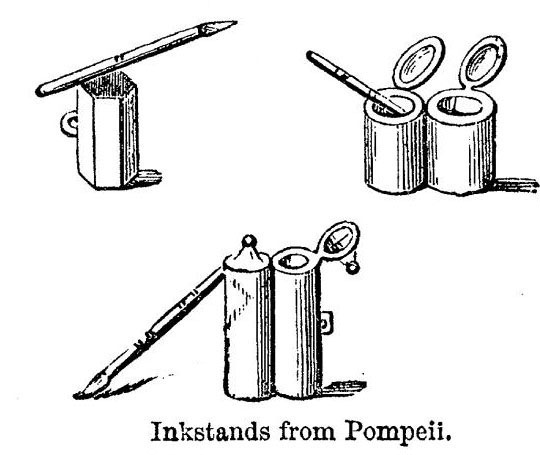Atramentum on:
[Wikipedia]
[Google]
[Amazon]
 Atramentum or atrament, generally means a very black, usually liquid, substance. For example, an octopus may emit a puff of atrament (see cephalopod ink).
In
Atramentum or atrament, generally means a very black, usually liquid, substance. For example, an octopus may emit a puff of atrament (see cephalopod ink).
In
 Atramentum or atrament, generally means a very black, usually liquid, substance. For example, an octopus may emit a puff of atrament (see cephalopod ink).
In
Atramentum or atrament, generally means a very black, usually liquid, substance. For example, an octopus may emit a puff of atrament (see cephalopod ink).
In ancient Rome
In modern historiography, ancient Rome refers to Roman civilisation from the founding of the city of Rome in the 8th century BC to the collapse of the Western Roman Empire in the 5th century AD. It encompasses the Roman Kingdom (753–509 BC ...
, the term ''atramentum'' signified any black colouring substance used for any purpose. The Romans distinguished three principal kinds of atramentum, one called ''librarium'' (or ''scriptorium''), another called ''sutorium'', the third ''tectorium''.
Atramentum librarium was the writing ink of Roman times, atramentum sutorium was used by shoemakers for dyeing leather, and atramentum tectorium (or pidorium) was used by painters for some purposes, apparently as a sort of varnish.
''Atramentous'' is a related adjective which means "black as ink". Historically, ''to atrament something'' would mean to write something down with ink. The word ''atrament'' is related to modern English ''atrocious'': both originate from Latin ''atrare'', which presumably meant to make something black.
According to the ''Pigment Compendium'', atramentum is a historical pigment or ink based on carbon black
Carbon black (subtypes are acetylene black, channel black, furnace black, lamp black and thermal black) is a material produced by the incomplete combustion of coal and coal tar, vegetable matter, or petroleum products, including fuel oil, fluid ...
. The painter Apelles has been credited for making ''atramentum elephantinum'' by burning ivory
Ivory is a hard, white material from the tusks (traditionally from elephants) and teeth of animals, that consists mainly of dentine, one of the physical structures of teeth and tusks. The chemical structure of the teeth and tusks of mammals i ...
, and Pliny the Elder
Gaius Plinius Secundus (AD 23/2479), called Pliny the Elder (), was a Roman author, naturalist and natural philosopher, and naval and army commander of the early Roman Empire, and a friend of the emperor Vespasian. He wrote the encyclopedic ' ...
in his '' Natural History'' comments on Apelles' skilled use of black varnish.
In one modern commercial usage of the word, atramentum is a deep black colouring substance manufactured by a reaction of an iron salt with tannic acid
Tannic acid is a specific form of tannin, a type of polyphenol. Its weak acidity ( pKa around 6) is due to the numerous phenol groups in the structure. The chemical formula for commercial tannic acid is often given as C76H52O46, which corresp ...
(the tannic acid for this purpose is often extracted from oak bark). It is a historically important black dye or pigment
A pigment is a colored material that is completely or nearly insoluble in water. In contrast, dyes are typically soluble, at least at some stage in their use. Generally dyes are often organic compounds whereas pigments are often inorganic compou ...
fundamentally different from carbon black or black iron oxide pigments. It was also sometimes called "ink stone". It appears greyish-black in water but the colour becomes very deep and lustrous in linseed oil.
The iron-based atramentum called ''iron gall ink
Iron gall ink (also known as common ink, standard ink, oak gall ink or iron gall nut ink) is a purple-black or brown-black ink made from iron salts and tannic acids from vegetable sources. It was the standard ink formulation used in Europe for ...
'' was in popular use from about the 12th to 19th century. It is currently a subject of conservation effort since many valuable collections are written using it but it causes ''ink corrosion''. In Jewish tradition, scribes
A scribe is a person who serves as a professional copyist, especially one who made copies of manuscripts before the invention of automatic printing.
The profession of the scribe, previously widespread across cultures, lost most of its promin ...
made use of copper sulphate Copper sulfate may refer to:
* Copper(II) sulfate, CuSO4, a common compound used as a fungicide and herbicide
* Copper(I) sulfate
Copper(I) sulfate, also known as cuprous sulfate, is an inorganic compound with the chemical formula Cu2 SO4. I ...
crystals (copper vitriol) in writing holy writ, which did not cause the corrosion of the ink.Shulhan Arukh
The ''Shulchan Aruch'' ( he, שֻׁלְחָן עָרוּך , literally: "Set Table"), sometimes dubbed in English as the Code of Jewish Law, is the most widely consulted of the various legal codes in Judaism. It was authored in Safed (today in I ...
, ''Yoreh De'ah'' (Hil. ''Sefer Torah'' § 271:6).
See also
*Ink
Ink is a gel, sol, or solution that contains at least one colorant, such as a dye or pigment, and is used to color a surface to produce an image, text, or design. Ink is used for drawing or writing with a pen, brush, reed pen, or quill. Thicker ...
*''Coprinopsis atramentaria
''Coprinopsis atramentaria'', commonly known as the common ink cap or inky cap, is an edible (although poisonous when combined with alcohol) mushroom found in Europe and North America. Previously known as ''Coprinus atramentarius'', it is th ...
''
*''Victaphanta atramentaria
''Victaphanta atramentaria'', common name the Gippsland black snail, is a species of carnivorous air-breathing land snail, a terrestrial pulmonate gastropod mollusk in the family Rhytididae.
Distribution
This species is endemic to Australia and ...
''
References
{{reflist Pigments